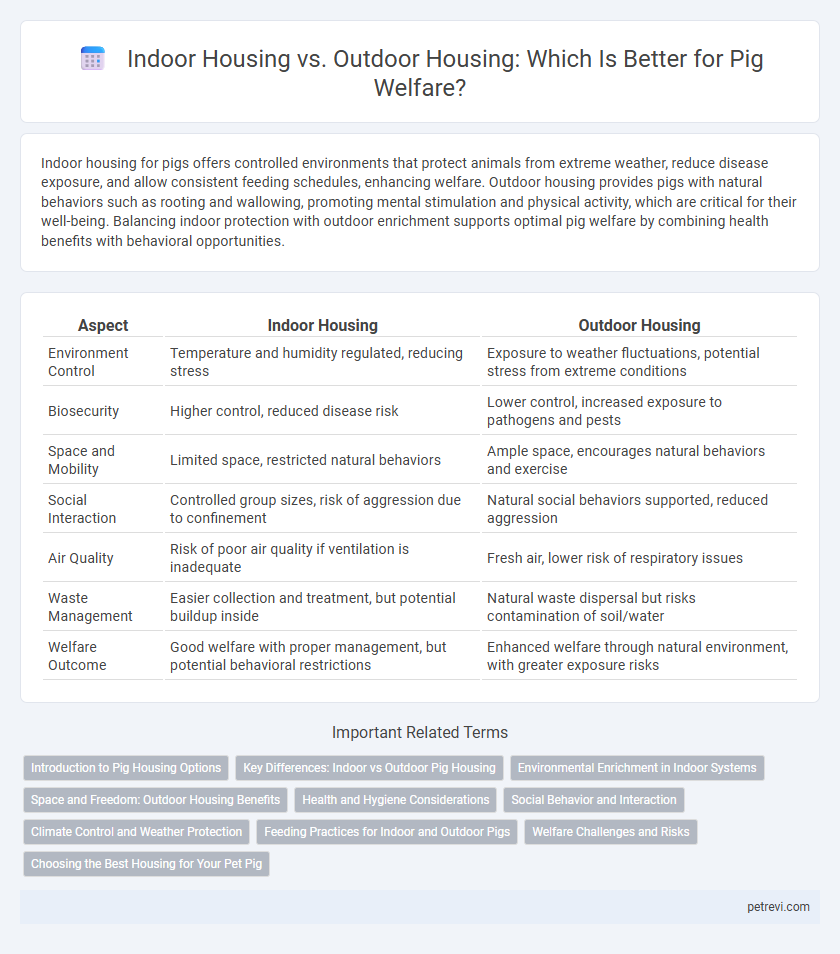Indoor housing for pigs offers controlled environments that protect animals from extreme weather, reduce disease exposure, and allow consistent feeding schedules, enhancing welfare. Outdoor housing provides pigs with natural behaviors such as rooting and wallowing, promoting mental stimulation and physical activity, which are critical for their well-being. Balancing indoor protection with outdoor enrichment supports optimal pig welfare by combining health benefits with behavioral opportunities.
Table of Comparison
| Aspect | Indoor Housing | Outdoor Housing |
|---|---|---|
| Environment Control | Temperature and humidity regulated, reducing stress | Exposure to weather fluctuations, potential stress from extreme conditions |
| Biosecurity | Higher control, reduced disease risk | Lower control, increased exposure to pathogens and pests |
| Space and Mobility | Limited space, restricted natural behaviors | Ample space, encourages natural behaviors and exercise |
| Social Interaction | Controlled group sizes, risk of aggression due to confinement | Natural social behaviors supported, reduced aggression |
| Air Quality | Risk of poor air quality if ventilation is inadequate | Fresh air, lower risk of respiratory issues |
| Waste Management | Easier collection and treatment, but potential buildup inside | Natural waste dispersal but risks contamination of soil/water |
| Welfare Outcome | Good welfare with proper management, but potential behavioral restrictions | Enhanced welfare through natural environment, with greater exposure risks |
Introduction to Pig Housing Options
Indoor pig housing provides controlled environments that enhance temperature regulation, biosecurity, and ease of monitoring animal health, which can reduce stress and disease incidence. Outdoor housing offers pigs natural behaviors such as rooting and foraging, promoting psychological well-being and physical activity, though it may expose them to environmental stressors. Selection of housing systems depends on balancing animal welfare benefits with management practices and environmental conditions specific to pig production.
Key Differences: Indoor vs Outdoor Pig Housing
Indoor pig housing offers controlled temperature, ventilation, and protection from predators, enhancing disease management and biosecurity. Outdoor pig housing provides natural sunlight, fresh air, and space for rooting and natural behaviors, promoting mental well-being and physical health. Key differences include environmental control in indoor systems versus behavioral freedom and exposure in outdoor systems, impacting overall pig welfare outcomes.
Environmental Enrichment in Indoor Systems
Indoor housing for pigs provides controlled environmental enrichment options such as manipulable materials, rooting substrates, and structured space to promote natural behaviors and reduce stress. These enrichment elements improve welfare by enhancing cognitive stimulation, decreasing aggression, and preventing stereotypic behaviors common in intensive indoor systems. Providing diverse, accessible enrichment in indoor environments is essential for optimal pig welfare compared to the more variable opportunities available in outdoor housing.
Space and Freedom: Outdoor Housing Benefits
Outdoor housing provides pigs with significantly more space to move freely, promoting natural behaviors such as rooting, foraging, and social interaction. Increased space reduces stress levels and the risk of aggressive behaviors, enhancing overall welfare. Access to varied terrain and fresh air supports physical health and mental stimulation, which are often limited in indoor housing systems.
Health and Hygiene Considerations
Indoor housing for pigs offers controlled environments that reduce exposure to parasites and infectious diseases, improving overall health and hygiene. However, inadequate ventilation and overcrowding in indoor systems can increase respiratory problems and ammonia buildup, negatively affecting pig welfare. Outdoor housing allows natural behaviors and fresh air, but pigs are more exposed to pathogens, mud, and extreme weather conditions, requiring careful management to maintain hygiene and prevent health issues.
Social Behavior and Interaction
Indoor housing for pigs allows controlled environments that can limit natural social behaviors, potentially causing stress due to restricted movement and reduced opportunities for interaction. Outdoor housing promotes natural social interactions by providing pigs with space for rooting, exploring, and establishing social hierarchies, which enhances their overall welfare. Studies show that pigs in outdoor systems exhibit more positive social behaviors such as play and grooming, leading to improved psychological health.
Climate Control and Weather Protection
Indoor housing for pigs provides precise climate control, maintaining consistent temperature and humidity levels essential for optimal pig welfare. This environment protects pigs from extreme weather conditions such as heat, cold, rain, and wind, reducing stress and the risk of illness. Outdoor housing exposes pigs to variable weather, which can compromise comfort and health unless adequate shelter and bedding are provided to mitigate harsh environmental effects.
Feeding Practices for Indoor and Outdoor Pigs
Feeding practices for indoor pigs typically involve controlled diets with precise nutrient formulations delivered through automated systems, ensuring consistent intake and minimizing waste. Outdoor pigs rely on natural foraging supplemented with feed, promoting diverse diets but requiring careful management to prevent over- or under-feeding. Both systems must balance nutritional needs with environmental conditions to optimize pig welfare and growth performance.
Welfare Challenges and Risks
Indoor housing for pigs often leads to welfare challenges such as restricted movement, increased aggression due to overcrowding, and higher risks of respiratory diseases from poor ventilation. Outdoor housing exposes pigs to environmental risks including temperature extremes, parasites, and predation, but generally allows for more natural behaviors and better mental well-being. Balancing the risks of disease and injury with the benefits of natural behaviors remains a critical consideration in pig welfare management.
Choosing the Best Housing for Your Pet Pig
Indoor housing for pet pigs offers controlled temperature, protection from predators, and easier monitoring of health, promoting optimal welfare. Outdoor housing allows natural behaviors like rooting and grazing, contributing to mental stimulation and physical exercise, but requires secure fencing and shelter from extreme weather. Selecting the best housing depends on balancing environmental control, safety, and enrichment to ensure your pig's well-being.
Indoor housing vs Outdoor housing for Pig welfare Infographic

 petrevi.com
petrevi.com